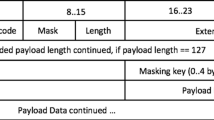Abstract
Video live streaming now represents over 34.97% of the Internet traffic. Typical distribution architectures for this type of service heavily rely on CDNs that enable to meet the stringent QoS requirements of live video applications. As CDN-based solutions are costly to operate, a number of solutions that complement CDN servers with WebRTC have emerged. WebRTC enables direct communications between browsers (viewers). The key idea is to enable viewer to viewer (V2V) video chunks exchanges as far as possible and revert to the CDN servers only if the video chunk has not been received before the timeout. In this work, we present the study we performed on an operational hybrid live video system. Relying on the per exchange statistics that the platform collects, we first present an high level overview of the performance of the system in the wild. A key performance indicator is the fraction of V2V traffic of the system. We demonstrate that the overall performance is driven by a small fraction of users. By further profiling individual clients upload and download performance, we demonstrate that the clients responsible for the chunk losses, i.e. chunks that are not fully uploaded before the deadline, have a poor uplink access. We devised a work-round strategy, where each client evaluates its uplink capacity and refrains from sending to other clients if its past performance is too low. We assess the effectiveness of the approach on the Grid5000 testbed and present live results that confirm the good results achieved in a controlled environment. We are indeed able to reduce the chunk loss rate by almost a factor of two with a negligible impact on the amount of V2V traffic .
Access this chapter
Tax calculation will be finalised at checkout
Purchases are for personal use only
Similar content being viewed by others
Notes
- 1.
Note that the good users in Fig. 8 can experience CLR higher than 20% for some categories, as the threshold of 20% applies to the average CLR and not per category.
References
Cohen, B.: Incentives build robustness in BitTorrent. In: Workshop on Economics of Peer-to-Peer systems, vol. 6 (2003)
Alex Bybyk 2(5) (2020). https://restream.io/blog/live-streaming-statistics/. Accessed 18 Oct 2020
Bergkvist, A., Burnett, D.C., Jennings,C., Narayanan, A., Aboba, B.: Webrtc 1.0: Real-time commu- nication between browsers. Working draft, W3C (2012)
Sarkar, I., Rouibia, S., Pacheco, D.L., Urvoy-Keller, G.: Proactive Information Dissemination in WebRTC-based Live Video Distribution. In: IWCMC, pp. 304–309 (2020)
Bruneau-Queyreix, J., Lacaud, M., Négru, D.: Increasing End-User’s QoE with a Hybrid P2P/Multi-Server streaming solution based on dash.js and webRTC (2017). ffhal-01585219f
Rhinow, F., Veloso, P.P., Puyelo, C., Barrett, S., Nuallain, E.O.: P2P live video streaming in WebRTC. In: World Congress on Computer Applications and Information Systems (WCCAIS), Hammamet, vol. 2014, pp. 1–6 (2014). https://doi.org/10.1109/WCCAIS.2014.6916588
Hei, X., Liang, C., Liang, J., Liu, Y., Ross, K.: A measurement study of a large-scale P2P IPTV system. IEEE Trans. Multimedia 9, 1672–1687 (2008). https://doi.org/10.1109/TMM.2007.907451
Silverston, T., Jakab, L., Cabellos-Aparicio, A., Fourmaux, O., Salamatian, K., et al.: Large-scale Measurement Experiments of P2P-TV Systems Insights on Fairness and Locality. Signal Process. Image Commun. 26(7), 327–338 (2011). ff10.1016/j.image.2011.01.007ff. ffhal-00648019f
Bolze, R., et al.: Grid’5000: a large scale and highly reconfigurable experimental grid testbed. Int. J. High Perform. Comput. Appl. 20(4), 481–494 (2006)
Author information
Authors and Affiliations
Corresponding author
Editor information
Editors and Affiliations
Rights and permissions
Copyright information
© 2021 Springer Nature Switzerland AG
About this paper
Cite this paper
Sarkar, I., Roubia, S., Lopez-Pacheco, D.M., Urvoy-Keller, G. (2021). A Data-Driven Analysis and Tuning of a Live Hybrid CDN/V2V Video Distribution System. In: Hohlfeld, O., Lutu, A., Levin, D. (eds) Passive and Active Measurement. PAM 2021. Lecture Notes in Computer Science(), vol 12671. Springer, Cham. https://doi.org/10.1007/978-3-030-72582-2_8
Download citation
DOI: https://doi.org/10.1007/978-3-030-72582-2_8
Published:
Publisher Name: Springer, Cham
Print ISBN: 978-3-030-72581-5
Online ISBN: 978-3-030-72582-2
eBook Packages: Computer ScienceComputer Science (R0)




